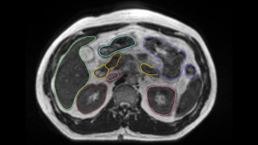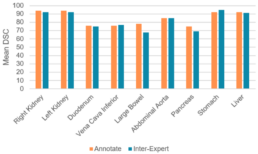A new hope for pancreatic cancer?
Pancreatic cancer is the 12th most common cancer in the world, representing 3% of all cancers [1]. There were more than 495,000 new cases of pancreatic cancer in 2020. Pancreatic cancer has the highest mortality rate of all major cancers. The 5-year relative survival rate is very low at just 5 to 10 percent, which makes pancreatic cancer one of the cancers with the lowest survival rate [2].
Current management
Up to now, the current main option for treating non-metastatic pancreatic cancer is surgery as it is considered a potentially curative treatment. These cancers account for less than 20% of pancreatic cancer patients. The remaining patients have either distant metastases (40%) or locally advanced unresectable pancreatic cancer (LAPC) (40%). The median survival has consistently been reported to be between 10 and 12 months [3].
A new hope?
The most definitive trial on LAPC patients, the LAP-07 trial (an international, open-label, phase 3 randomized trial, 449 patients), has shown no improvement of the combination of chemotherapy and non-ablative radiotherapy (RT) over chemotherapy alone, thus demonstrating the need for more effective local approaches [4].
Because of the uncertainty in the treatment of upper abdominal malignancies due to respiratory and digestive motion, earlier RT approaches, including low dose stereotactic body radiotherapy (SBRT), were restricted to radiation dose of palliative levels (i.e. 54 Grey [Gy] in 30 fractions) [5].
Recent advances in the field of radiotherapy have opened the door to new treatment possibilities. MR-guided RT (MRgRT) systems enable daily adaptive planning while correcting for respiratory and digestive motion thanks to an integrated MR image guidance. As such, these techniques have allowed to escalate the dose beyond the palliative levels with initial studies demonstrating improved survival [5].
Several recently published Stereotactic MR-guided on-table Adaptive Radiation Therapy (SMART) studies have demonstrated improved treatment efficacy and reduced toxicity compared to outcomes from non-ablative radiation therapy [6].
In October this year, a phase III randomized controlled trial titled “Locally Advanced Pancreatic cancer treated with ABLAtivE stereotactic MRI-guided adaptive radiation therapy” – also known as LAP-ABLATE – has been launched to compare stand-alone multi-agent chemotherapy to the combination of chemotherapy and MRI-guided ablative dose radiation therapy. The goal is to determine MR linacs role in improving overall survival outcomes [7].
How can we help?
TheraPanacea has released an AI-powered auto-contouring tool for radiotherapy planning including OARs and lymph nodes for all anatomies. Following RTOG guidelines [8-9], ART-Plan™ and Annotate now offer new perspectives towards a fully automatic delineation of OARs for MR images.
Always aware of the newest advancements in RT, TheraPanacea has already released a model dedicated to the MR-Linac workflow, including models needed for the treatment of pancreatic cancer. The model for the abdominal region (TrueFisp) includes all OARs needed for planning the treatment: aorta, duodenum, external contour, inferior vena cava, kidneys (L/R), large bowel, liver, pancreas, stomach (spinal cord will be added in a next release). The image below displays an non-edited example of the Abdo TrueFisp MR model.

Recently, TheraPanacea has conducted a quantitative evaluation for its Abdo TrueFisp MR model, in which manual and automated delineation using ART-PlanTM’s module Annotate were compared. DSC have been calculated for different organs and compared against the DSC between experts.

For all organs, Annotate has demonstrated expert-like performance. In fact, for 6 out of 9 organs, Annotate has outperformed the clinical experts, showing its ability to help in the standardization of the delineation practice.
Especially in the MRgRT workflow, reducing the time needed for OAR delineations is of extreme importance as this can not only help decrease the overall time needed for the planning and replanning of each patient, but also eventually increase the overall patient throughput. That means that, with help of ART-PlanTM, more patients could benefit from these promising technologies and treatment advancements.
Read more about how TheraPanacea is helping advance the MRgRT field (including with the generation of synthetic CTs) in our white paper “MR-only radiotherapy planning with ART-Plan™ Annotate and Pseudo-CT”
Want to learn more about our dedicated MRgRT solutions?
[3] Suker M, Beumer BR, Sadot E, Marthey L, Faris JE, Mellon EA, El-Rayes BF, Wang-Gillam A, Lacy J, Hosein PJ, Moorcraft SY, Conroy T, Hohla F, Allen P, Taieb J, Hong TS, Shridhar R, Chau I, van Eijck CH, Koerkamp BG. FOLFIRINOX for locally advanced pancreatic cancer: a systematic review and patient-level meta-analysis. Lancet Oncol. 2016 Jun;17(6):801-810. doi: 10.1016/S1470-2045(16)00172-8. Epub 2016 May 6. PMID: 27160474; PMCID: PMC5527756.
[4] Hammel P, Huguet F, van Laethem JL, Goldstein D, Glimelius B, Artru P, Borbath I, Bouché O, Shannon J, André T, Mineur L, Chibaudel B, Bonnetain F, Louvet C; LAP07 Trial Group. Effect of Chemoradiotherapy vs Chemotherapy on Survival in Patients With Locally Advanced Pancreatic Cancer Controlled After 4 Months of Gemcitabine With or Without Erlotinib: The LAP07 Randomized Clinical Trial. JAMA. 2016 May 3;315(17):1844-53. doi: 10.1001/jama.2016.4324. PMID: 27139057.
[5] Tringale KR, Tyagi N, Marsha Reyngold, Romesser PB, Wu A, O’Reilly EM, Varghese AM, Godoy Scripes P, Khalil DN, Park W, Yu K, Crane CH. Stereotactic ablative radiation for pancreatic cancer on a 1.5 Telsa magnetic resonance-linac system. Phys Imaging Radiat Oncol. 2022 Oct 28;24:88-94. doi: 10.1016/j.phro.2022.10.003. PMID: 36386447; PMCID: PMC9640311.
[7] https://clinicaltrials.gov/ct2/show/NCT05585554
[8] Jabbour SK, Hashem SA, Bosch W, Kim TK, Finkelstein SE, Anderson BM, Ben-Josef E, Crane CH, Goodman KA, Haddock MG, Herman JM, Hong TS, Kachnic LA, Mamon HJ, Pantarotto JR, Dawson LA. Upper abdominal normal organ contouring guidelines and atlas: a Radiation Therapy Oncology Group consensus. Pract Radiat Oncol. 2014 Mar-Apr;4(2):82-89. doi: 10.1016/j.prro.2013.06.004. Epub 2013 Aug 7. PMID: 24890348; PMCID: PMC4285338.
[9] Kong FM, Ritter T, Quint DJ, Senan S, Gaspar LE, Komaki RU, Hurkmans CW, Timmerman R, Bezjak A, Bradley JD, Movsas B, Marsh L, Okunieff P, Choy H, Curran WJ Jr. Consideration of dose limits for organs at risk of thoracic radiotherapy: atlas for lung, proximal bronchial tree, esophagus, spinal cord, ribs, and brachial plexus. Int J Radiat Oncol Biol Phys. 2011 Dec 1;81(5):1442-57. doi: 10.1016/j.ijrobp.2010.07.1977. Epub 2010 Oct 8. PMID: 20934273; PMCID: PMC3933280.
Related Posts
25 June 2024
Unlocking the Potential of AI Auto-Contouring in Radiotherapy at HELSE Bergen [WEBINAR]
Clinically Relevant AI in Radiation…
24 October 2023
Innovations in Radiation Oncology: Harnessing AI for better patients outcomes [WEBINAR]
Clinically Relevant AI in Radiation…




